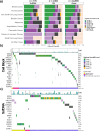Maximizing the clinical utility and performance of cytology samples for comprehensive genetic profiling
- PMID: 39747849
- PMCID: PMC11696557
- DOI: 10.1038/s41467-024-55456-8
Maximizing the clinical utility and performance of cytology samples for comprehensive genetic profiling
Abstract
Comprehensive molecular profiling by next-generation sequencing has revolutionized tumor classification and biomarker evaluation. However, routine implementation is challenged by the scant nature of diagnostic material obtained through minimally invasive procedures. Here, we describe our long-term experience in profiling cytology samples with an in-depth assessment of the performance, quality metrics, biomarker identification capabilities, and potential pitfalls. We highlight the impact of several optimization strategies to maximize performance with 4,871 prospectively sequenced clinical cytology samples tested by MSK-IMPACTTM. Special emphasis is given to the use of residual supernatant cell-free DNA (ScfDNA) as a valuable source of tumor DNA. Overall, cytology samples are similar in performance to surgical samples in identifying clinically relevant genomic alterations, achieving success rates up to 93% with full optimization. While cell block (CB) samples have excellent performance overall, low-level cross-contamination is identified in a small proportion of cases (4.7%), a common pitfall intrinsic to the processing of paraffin blocks, suggesting that more stringent precautions and processing modifications should be considered in quality control initiatives. By contrast ScfDNA samples have negligible contamination. Finally, ScfDNA testing exclusively used as a rescue strategy, delivered successful results in 71% of cases where tumor tissue from CB was depleted.
© 2024. The Author(s).
Conflict of interest statement
Competing interests: C.V. reports intellectual property rights and equity interest in Paige.AI, Inc. A.R.B. has ownership/equity interests in Johnson and Johnson. M.B. has received advisory or consulting fees from AstraZeneca, Eli Lilly and Company, and PetDx, Inc. M.L. has received advisory or consulting fees from Takeda Oncology, Janssen Pharmaceuticals, AstraZeneca, ADC Therapeutics, Paige.AI, Merck, Bayer, and Lilly Oncology and has received research funding from Loxo Oncology, Helsinn Therapeutics, Merus NV, Elevation Oncology, and Rain Therapeutics. O.L. has received advisory or consulting fees from Hologic and Janssen Research & Development, LLC. M.A. has received advisory or consulting fees from Axis Medical Education, Clinical Education Alliance, LLC, Merck Sharp & Dohme, PeerView Institute for Medical Education (PVI), Physicians’ Education Resource, RMEI Medical Education, LLC, and Roche. The following Authors declare no competing interests: D.K., S.Y., S.N., K.N., R.F., N.R., I.R., J.C., and A.Y.
Figures





Update of
-
Maximizing the clinical utility and performance of cytology samples for comprehensive genetic profiling - A report on the impact of process optimization through the analysis of 4,871 cytology samples profiled by MSK-IMPACT.Res Sq [Preprint]. 2024 Jul 23:rs.3.rs-4746484. doi: 10.21203/rs.3.rs-4746484/v1. Res Sq. 2024. Update in: Nat Commun. 2025 Jan 2;16(1):116. doi: 10.1038/s41467-024-55456-8. PMID: 39108489 Free PMC article. Updated. Preprint.
Similar articles
-
Maximizing the clinical utility and performance of cytology samples for comprehensive genetic profiling - A report on the impact of process optimization through the analysis of 4,871 cytology samples profiled by MSK-IMPACT.Res Sq [Preprint]. 2024 Jul 23:rs.3.rs-4746484. doi: 10.21203/rs.3.rs-4746484/v1. Res Sq. 2024. Update in: Nat Commun. 2025 Jan 2;16(1):116. doi: 10.1038/s41467-024-55456-8. PMID: 39108489 Free PMC article. Updated. Preprint.
-
Utilization of cytology smears improves success rates of RNA-based next-generation sequencing gene fusion assays for clinically relevant predictive biomarkers.Cancer Cytopathol. 2021 May;129(5):374-382. doi: 10.1002/cncy.22381. Epub 2020 Oct 29. Cancer Cytopathol. 2021. PMID: 33119213 Free PMC article.
-
Comparison of cytocentrifugation supernatant fluid and formalin-fixed paraffin-embedded tissue for targeted next-generation sequencing.Cancer Cytopathol. 2019 May;127(5):297-305. doi: 10.1002/cncy.22126. Epub 2019 Apr 1. Cancer Cytopathol. 2019. PMID: 30933438
-
Application and optimization of minimally invasive cell-free DNA techniques in oncogenomics.Tumour Biol. 2018 Feb;40(2):1010428318760342. doi: 10.1177/1010428318760342. Tumour Biol. 2018. PMID: 29484962 Review.
-
Next generation sequencing in cytology.Cytopathology. 2021 Sep;32(5):588-595. doi: 10.1111/cyt.12974. Epub 2021 Apr 1. Cytopathology. 2021. PMID: 33792981 Free PMC article. Review.
References
-
- Garraway, L. A. Genomics-driven oncology: framework for an emerging paradigm. J. Clin. Oncol.31, 1806–1814 (2013). - PubMed
-
- Wakai, T. et al. Next-generation sequencing-based clinical sequencing: toward precision medicine in solid tumors. Int. J. Clin. Oncol.24, 115–122 (2019). - PubMed
-
- Baum, J. E. et al. Accuracy of next-generation sequencing for the identification of clinically relevant variants in cytology smears in lung adenocarcinoma. Cancer Cytopathol.125, 398–406 (2017). - PubMed
Publication types
MeSH terms
Substances
Grants and funding
LinkOut - more resources
Full Text Sources
Medical

